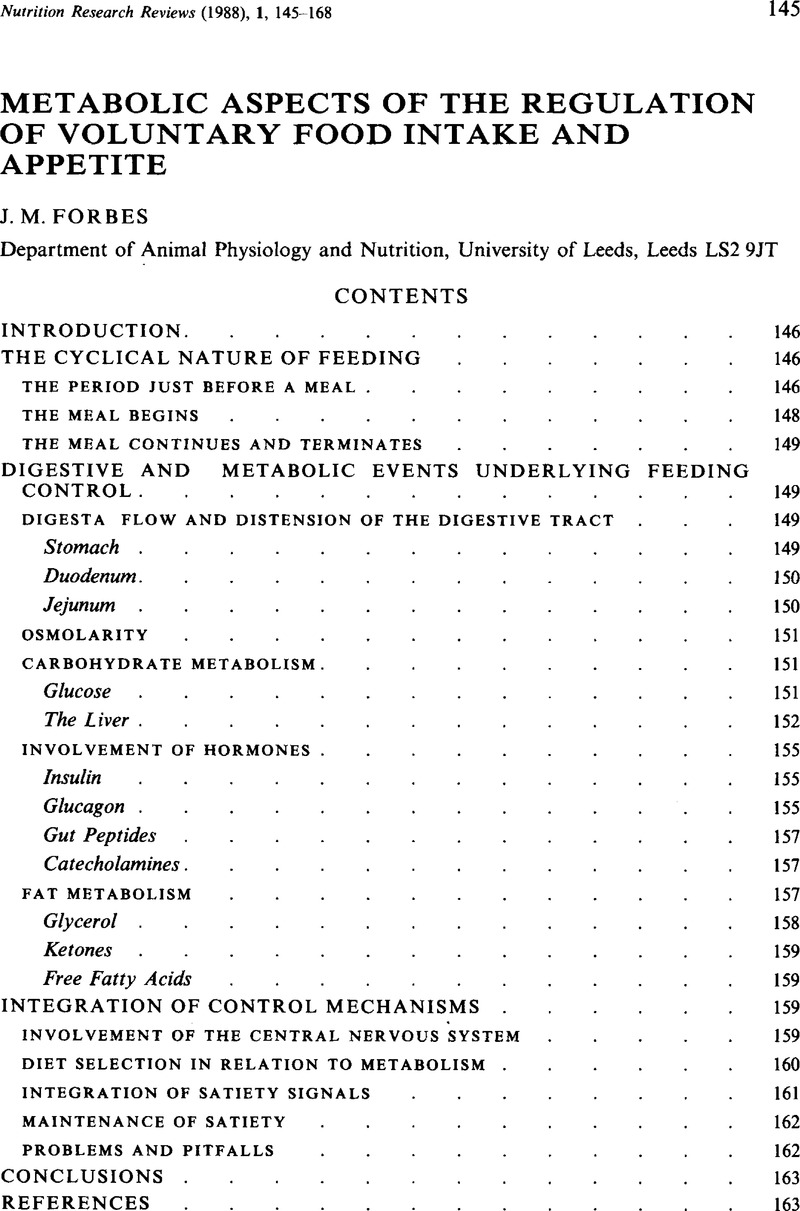Crossref Citations
This article has been cited by the following publications. This list is generated based on data provided by Crossref.
Forbes, J. M.
and
Blundell, J. E.
1989.
Central nervous control of voluntary food intake.
BSAP Occasional Publication,
Vol. 13,
Issue. ,
p.
7.
Azahan, E. A. Engku
and
Forbes, J. M.
1989.
Growth, food intake and energy balance of layer and broiler chickens offered glucose in the drinking water and the effect of dietary protein content.
British Poultry Science,
Vol. 30,
Issue. 4,
p.
907.
Bray, G A
1989.
1989 McCollum Award lecture. Genetic and hypothalamic mechanisms for obesity--finding the needle in the haystack.
The American Journal of Clinical Nutrition,
Vol. 50,
Issue. 5,
p.
891.
Johnson, T.R.
and
Combs, D.K.
1991.
Effects of Prepartum Diet, Inert Rumen Bulk, and Dietary Polyethylene Glycol on Dry Matter Intake of Lactating Dairy Cows.
Journal of Dairy Science,
Vol. 74,
Issue. 3,
p.
933.
Forbes, J. M.
1992.
Metabolic aspects of satiety.
Proceedings of the Nutrition Society,
Vol. 51,
Issue. 1,
p.
13.
Johnson, T.R.
and
Combs, D.K.
1992.
Effects of Inert Rumen Bulk on Dry Matter Intake in Early and Midlactation Cows Fed Diets Differing in Forage Content.
Journal of Dairy Science,
Vol. 75,
Issue. 2,
p.
508.
Boujard, Thierry
and
Leatherland, John F.
1992.
Circadian rhythms and feeding time in fishes.
Environmental Biology of Fishes,
Vol. 35,
Issue. 2,
p.
109.
Bergner, H.
and
Mnilk, Beatrix
1993.
Einfluss der fütterungsfrequenz auf das ergebnis der stoffwechselorientierten lysinbedarfsbestimmung und der N‐bilanz bei masthähnchen‐küken.
Archiv für Tierernaehrung,
Vol. 43,
Issue. 3,
p.
227.
Jobling, M.
and
Miglavs, I.
1993.
The size of lipid depots‐a factor contributing to the control of food intake in Arctic charr, Salvelinus alpinus?.
Journal of Fish Biology,
Vol. 43,
Issue. 3,
p.
487.
Dulphy, J.P.
and
Demarquilly, C.
1994.
The regulation and prediction of feed intake in ruminants in relation to feed characteristics.
Livestock Production Science,
Vol. 39,
Issue. 1,
p.
1.
Forbes, J. M.
1995.
Voluntary intake: a limiting factor to production in high-yielding dairy cows?.
BSAP Occasional Publication,
Vol. 19,
Issue. ,
p.
13.
Lee, G.J.
Atkins, K.D.
and
Mortimer, S.I.
1995.
Variation between Merino ewes in pasture intake 1. Between flock differences and some environmental sources of variation.
Livestock Production Science,
Vol. 41,
Issue. 2,
p.
133.
Dado, R.G.
and
Allen, M.S.
1995.
Intake Limitations, Feeding Behavior, and Rumen Function of Cows Challenged with Rumen Fill from Dietary Fiber or Inert Bulk.
Journal of Dairy Science,
Vol. 78,
Issue. 1,
p.
118.
Van Houtert, Martin F.J.
and
Sykes, Andrew R.
1996.
Implications of nutrition for the ability of ruminants to withstand gastrointestinal nematode infections.
International Journal for Parasitology,
Vol. 26,
Issue. 11,
p.
1151.
Forbes, J.Michael
1998.
Dietary awareness.
Applied Animal Behaviour Science,
Vol. 57,
Issue. 3-4,
p.
287.
Ingvartsen, K. L.
Friggens, N. C.
and
Faverdin, P.
1999.
Food intake regulation in late pregnancy and early lactation.
BSAP Occasional Publication,
Vol. 24,
Issue. ,
p.
37.
Rogers, Peter J.
1999.
Eating habits and appetite control: a psychobiological perspective.
Proceedings of the Nutrition Society,
Vol. 58,
Issue. 1,
p.
59.
Stubbs, R.James
1999.
Peripheral signals affecting food intake.
Nutrition,
Vol. 15,
Issue. 7-8,
p.
614.
Rogers, Peter J
and
Smit, Hendrik J
2000.
Food Craving and Food “Addiction”.
Pharmacology Biochemistry and Behavior,
Vol. 66,
Issue. 1,
p.
3.
Allen, Michael S.
2000.
Effects of Diet on Short-Term Regulation of Feed Intake by Lactating Dairy Cattle.
Journal of Dairy Science,
Vol. 83,
Issue. 7,
p.
1598.



